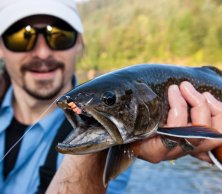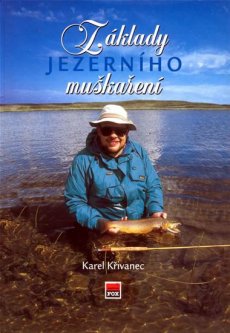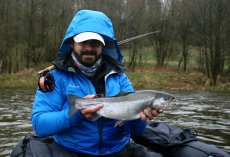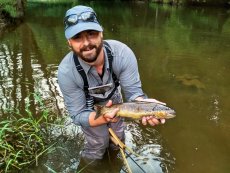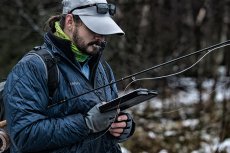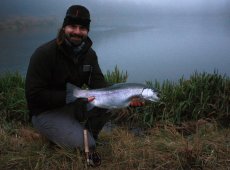If you want to be consistently successful at fly fishing for stillwater trout, you should definitely know all the proper fishing tactics and techniques that are typical of stillwater fly fishing and are really crucial to your effectiveness! The right flies combined with the perfect gear won't do you any good if you can't assess the situation on the water and adapt accordingly!

In my opinion, the most beautiful thing about stillwater fly fishing is the unpredictability in the behavior of trout and often their great food selectivity = the unintentional ability to often confuse the fisherman completely! 🙂 In the case of wild fish, I would - in this context - point out mainly their shyness and caution - experience, in the case of stocked trout I have to mention their "psychedelicity" in the form of large changes in behavior, which are mostly directly dependent mainly on the fishing pressure on the given area in combination with other factors that trout undoubtedly perceive.
If you want to be effective when fishing for stillwater salmonids, you must always evaluate the given situation well and counter it as much as possible with appropriately chosen fishing tactics, which can also provide several separate or combined techniques/methods! Appropriate assessment of the situation is absolutely crucial to your success, because if, for example, you come to water where fish activity is clearly visible on the surface and you start fishing with a sinking line at the bottom - just because that's how you like to fish - you might be yourself and enthusiastic from the fishing technique itself, but you will definitely not be very successful in catching those actively feeding fish under the surface!
☝️ But this smiling example hides a fundamental idea, mainly from the point of view of a personal approach to fly fishing, because it is very important to define your own boundaries and if you do not agree with a fishing technique, e.g. on principle or for other reasons, no one can force you to use it! Fly fishing is about experience and if you want to fish dry even when you would catch many more on nymphs, for example, or if you refuse to fish wild or domesticated fish for brightly colored Blobs and attractors, it is of course your free choice and I accept and respect the approach, because - as you probably already know about me - I myself have problems with some (mainly modern/competition) methods of "fly fishing"!
In any case, this special is not about coaching a strong-willed fly fishing personality, but about effective stillwater trout fishing using all available and permitted fly fishing techniques, which you should at least know to be free to choose the ones you will use and want to practice by the water! 😉
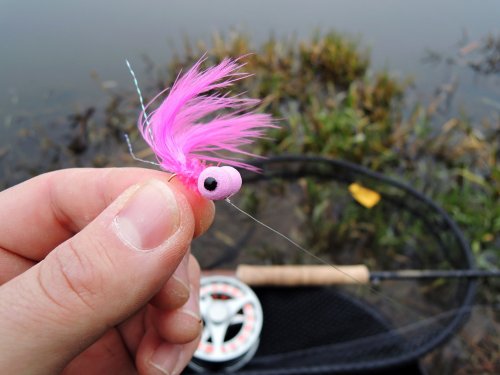
So, in terms of proper stillwater fishing tactics, I would recommend that you look around when you arrive at the lake and assess what is actually going on in and on the water! If the area is not large, feel free to walk around it and spend a little time getting to know it (in the case of a completely unknown area) or getting to know and understand the current conditions! The behavior of the fish, the behavior of other fishermen who are present near the water will tell you a lot. You will first be able to observe any activity of fish - the surface activity (mostly a positive sign), jumps of fish (often a negative indicator), fishing style of others - successful anglers - lengths of casts, lines used, number, sizes and colors of flies, etc. All these factors you they will help start the fishing - in the given situation - with the most suitable method! Definitely - even during the hunt itself - always monitor the surroundings and the water level, look for the possible occurrence of fish or, on the contrary, places spared from the greatest pressure, also pay close attention to the direction in which the wind is blowing = direction of food movement = probable movement of fish and evaluate the possible perspective of moving to these places! Everything is, of course, very relative, sometimes the fish are active where they don't show themselves, sometimes the fish really take best where it's obvious and, of course, in both cases, vice versa! Anyway, be proactive, think and keep evaluating the situation! Just watch out for overcombining, that also happens sometimes if you don't keep your cool! 😏
If nothing from the above happens after you arrive at the water, which would help you choose an effective fishing method, have prepared tactics according to the time of the season and your previous experience, for example. Just for a rough idea (especially for beginners without much experience) e.g. SPRING: 2 colored lures on an intermediate line + medium to fast retrieve, SUMMER: 2 - 3 small nymph or wet flies on a long leader on a floating line + slow retrieve, AUTUMN: 2 wet flies or smaller natural lures on hover or slow intermediate line + slow retrieve, WINTER: 1 booby nymph on a short leader on a sinking line + very slow retrieve! Of course, these pre-prepared tactics are not a dogma and a guarantee of immediate success in the mentioned time of year, but they will at least help you actively "play the game" and gradually find out the necessary information for the further development of your fishing!
As I already wrote in the related article of this stillwater FLY FISHING SPECIAL "Tackle & Equipment Of Stillwater Fly Fisherman", fly lines are absolutely pivotal and one could say that they are the most important part of a stillwater fly fisherman's equipment, and therefore I would also describe the most important and most frequently used techniques according to their use of stillwtaer trout fly fishing, including my personal experiences with each method!
FISHING TECHNIQUES WITH A FLOATING LINE: A floating fly line is, of course, a basic equipment for both the beginner and the advanced stillwater fly angler! Due to the length of the casts, it should clearly be a WF weight forward floating fly line, and as with the other types of lines that will be listed here, the stillwater fly angler should know and especially master all relevant and permitted methods of fishing with it, which are practiced mainly in warmer periods of the season (abundant occurrence of aquatic and terrestrial insects in the upper levels of the water column), or in shallow parts of the lake (fishing in the colder months of the season, where sinking lines would often get stuck to the bottom)!
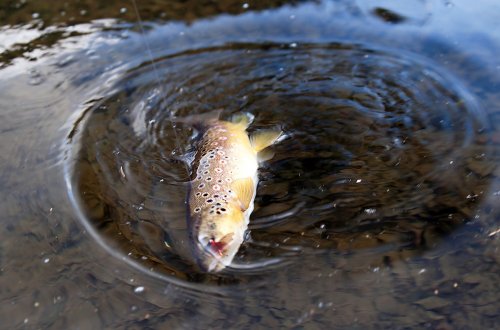
◼ Dry fly fishing is the most traditional technique of catching active fish that eat insects from the surface, using dry flies on a longer leader, which should be degreased so that it sinks and does not scare the rising fish! Depending on the activity of the fish, it is possible to use fly 1, but also 2 to 3 (worse casting with a long and light leader). This technique is particularly effective when catching active fish feeding on insects that have just hatched (warm spring, summer and early autumn months). With dry flies, you can fish passively = cast and wait for the fish to find the fly, or actively = cast the flies more often and revive them with different styles of attraction (depending on fish activity).
* Nowadays, the still waters are actively fished with floating lines, of course, also with various lures (more than once I successfully fished with a floating fly line and for Blobs slowly pulled under the surface) and surface streamers - poppers or subsurface fish fry patterns in autumn, when trout are chasing small fish on shallows (mainly on large reservoirs in the UK) - in our conditions, exceptionally only on natural type of stagnant trout reservoirs, or on coarse stagnant waters (sand pits, reservoirs), in which rainbow trout are also stocked, which survive there and in the autumn they already have the habits of a predator!
◼ Fishing with nymphs and wet flies is another popular fishing tactic with a floating line when the surface activity of the fish is not very strong, the trout are deeper and prefer the larval stages of aquatic insects (nymphs and pupae of midges, chironomids and mayflies) or dead insects , which floats in the water column (wet flies imitating drowned insects) or insects that normally live in water (corixa, shrimps, hoglouse). In such a case, it is ideal to fish with a long leader with 2-3 nymph or wet flies and gradually capture as much of the water column as possible, where fish can be found - depending on the length of the leader and the spacing of the flies - the clearer the water, the longer the leader and the spacing fly!
◼ Washing line technique is an excellent and natural method of fishing with small nymphs or wet flies very close to the water surface - even a few cm below it! An unbeatable method for catching apathetic fish in the warm summer months, when trout pass in the upper part of the water column and do not react to anything actively retrieved or to dry flies, because nothing concrete is hatching and trout do not trust surface flies. At such a moment comes the time for this method called "Washing line", which consists in suspending 1-2 smaller nymphs or wet flies between the floating end of the line and a well-floating fly (dry fly, booby nymph, FAB Blob, BUNG fly, Suspender Buzzer, Shuttlecock...) at the end of the leader! This setup will create a sort of "bridge" over the surface, with the small nymphs/wet flies suspended a few cm below the surface and completely casually waiting for passing fish to occasionally eat something that behaves naturally and requires nothing more from the fish than opening and shut mouth!
◼ The static fishing method "Dry-Dropper"/BUNG is one of the modern and still controversial methods of stillwater fishing with a floating line. It could be said that it is a kind of float fishing using fly fishing equipment and artificial flies, where a highly visible and strongly floating dry fly (thick and big CDC or foam BUNG indicator flies made of polycelon) serves as a catch indicator - on union grounds - or some kind of indicator/buoy that is only allowed to be used on private grounds. It is important that the leader with 1 - 2 flies has a perfect sag - for 100% indication of engagement even in windy conditions or slightly flowing water. For that reason, tungsten nymphs, lures, buzzers or other various patterns are used as point and dropper flies, which I don't want to mention anymore and because of which I don't like this method, because it really deviates from the basic principles of stillwater fly fishing! You should therefore resort to its use only in extreme cases - situations where the fish do not react at all to anything from actively retracted or passive dry flies => very cautiously accept (necessity of an indicator) only e.g. free-floating nymphs in the water column or just above bottom.

FISHING TECHNIQUE WITH HOVER LINE: As I have already written, I personally consider this type of line to be the most versatile type of lake fly line for year-round fishing with actively retrieved and smaller flies, and especially special fly lines that were developed for fishing on still waters! It could be said that with a hover subsurface fly line you can fish with the same techniques described above as with a floating line except for regular dry fly fishing and "static" fishing with a "Dry Dropper"/BUNG! You can easily practice fishing with actively retrieved wet flies and nymphs, which is one of my most popular methods of lake fly fishing, but also fishing a "Washing line" in the event that you do not need or do not want to have flies just below the surface, but e.g. a few tens of cm below her!
Thanks to the very slow sinking of the Hover type line (around 1 cm/sec), you can safely fish, for example, with smaller lures or unweighted smaller streamers for fish actively fishing in the upper parts of the water column or in shallower or overgrown parts of the lake, where you would with an intermediate or stuck fast at the bottom with a sinking line! Hover line is excellent for fishing in windy weather where the floating line would be quickly swept across the surface by the waves and the flies would be carried very quickly through the water column, which the fish could perceive as unnatural and untrustworthy behavior of their potential food!
FISHING TECHNIQUE WITH INTERMEDIATE LINES: Slow and fast intermediate lines are undoubtedly indispensable equipment for a stillwater fly fisherman, as you will be fishing with them for most of the fishing season, mainly due to the fact that these are universal types of stillwater fly lines designed mainly for faster revival of flies during fishing of fish active in the middle layers of the water column! Fast intermediate lines are therefore mainly used when fishing for actively moving - faster led lures, Blobs, Booby nymphs and streamers of various sizes when fishing for active/aggressive fish! Slow "intermediates" are mainly used when retrieve these lures more slowly, but also, for example, nymphs, wet flies, midges. Of course, it depends on the depth of the water you visit, but I expect rather standard conditions - a depth of, for example, up to 4-5 meters! Personally, I fish with intermediate lines mainly in the spring and autumn months with lures, or even in the summer when streamer fishing with one fly (natural water types) or when fishing with Booby nymphs in a column.
FISHING TECHNIQUE WITH A SINKING LINE: In our conditions, you will probably most often use sinking fly lines (grade S3 - S5 max. with regard to the depth of Czech trout still waters) when fishing with Booby Nymphs and Booby Streamers, especially in the cold months of the fishing season with slow fishing near the bottom. Especially in the winter months, the fish are already at the bottom, their metabolism has slowed down, but on the other hand, they will not disdain a big bite - they just have to catch up! So, a slowly retrieved Booby on a sinking line is very often the right choice, which gives you hope for a catch just before, or on the contrary after the water surface thaws! Of course, sinking lines can also be used during active and fast-retracting streamers, you just have to watch out for knots and the possibility of frequent stucking and tearing of streamers at the bottom! The now traditional stillwater method of Roly-Poly when fishing for extra-fast-retrieving Blobs also uses fast-sinking lines, but I fear that in our conditions this method will not be as successful as on the vast and deep English reservoirs from which it originates!
FISHING TECHNIQUE WITH MIDGE & SINK TIP: I have already described the style of fishing with this specific and actually the last commonly used type of lake fly line in the article "Tackle & Equipment Of Stillwater Fly Fisherman" in the paragraph ◼ Floating lines with a sink tip (Sink Tip fly lines)!
⭐ If you combine the essential knowledge you have gained from this article with other information from related publications from my FLY FISHING SPECIAL, which I devoted to stillwater fly fishing and effective trout fishing on still waters, it is certain that you are on a very good way to become an enthusiastic - and in most situations - also a successful stillwater fly fisherman! 😉
➡ STILLWATER FLY FISHING FROM A TO Z
➡ TOP FLIES FOR STILLWATER TROUT
➡ TACKLE & EQUIPMENT OF STILLWATER FLY FISHERMAN







